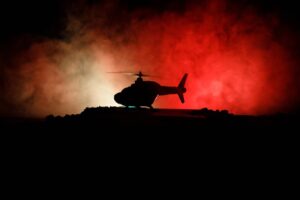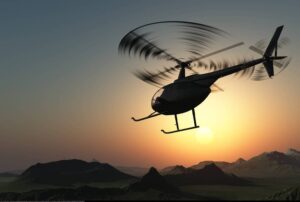Night vision devices let you see in the dark. You can see animals, people, and objects up to 1,000 yards away on a night with quality night vision goggles and scopes. Night vision monocular cameras let you take videos and photographs of things you can’t see in the dark with your naked eyes. Most importantly, night vision for rescue helicopters is especially helpful in rendering assistance and aiding in search and rescue operations.
There are two similar technologies used in night vision equipment. Traditional night vision devices utilize optoelectronic image enhancement, which operates by sensing small amounts of infrared light reflected off objects and amplifying that light electrically into a characteristic glowing green image.
A more modern technology, digital image enhancement, captures existing light on a digital image sensor and then enhances the images digitally in a full-color display.
Understanding Optoelectronic Image Enhancement

Older night vision equipment utilizes optoelectronic image enhancement technology. This technology utilizes a series of optical lenses and a special electronic vacuum tube to amplify and capture the visible and infrared light reflected off nearby objects.
The first lens in the system is called the objective lens. It captures two types of light: the faint visible light that bounces off the subject and some light from the lower part of the infrared spectrum. Like all light, this light comprises small particles known as photons.
These photons pass through the objective lens toward an image-intensifier tube. This special electronic vacuum tube is powered by two small AA or N-cell battery components.
The first part of the tube is known as the photocathode. This component turns the incoming photons into electrons. Do you remember from science class? Neutrons, photons, and electrons are tiny particles that form an atom’s components. Photons and neutrons come together to create the nucleus of the atom, while electrons orbit the nucleus and carry an electrical charge.
The newly-made electrons flow into the second part of the vacuum tube, known as the MCP (microchannel plate). The MCP is a tiny glass disc with millions of small holes that multiplies the electrons, thus amplifying the electric signal a few thousand times.
When electrons leave the image intensifier tube, they strike a screen covered in phosphor. These phosphors glow green when hit, making the image much brighter than the faint light that initially entered the objective lens. To observe the phosphor image, you use an ocular lens that lets you focus and potentially enlarge the image.
Why don’t traditional night vision images have color? When photons are converted into electrons, the color information is lost, and the original colored light becomes a black-and-white image. The reason for using green phosphors is that it’s the easiest color to see for long periods in the dark.
Understanding Digital Image Enhancement
Currently, many night vision devices use a digital form of traditional optoelectronic image enhancement technology. This results in night vision devices that are smaller, lighter, and more versatile.
In digital night vision, the light goes through the objective lens. It changes into a digital signal using a complementary metal-oxide-semiconductor (CMOS) sensor, similar to the ones found in digital video cameras. The electronic enhancement and magnification of the digital image happen before it’s sent to an LCD screen for viewing. A bigger CMOS sensor leads to higher image resolution, and many modern digital night vision devices can display and record full 1080p HD video.
Digital advancements have transformed night vision technology. In the past, digital night vision devices had less detailed images than traditional optical ones. However, today’s devices produce highly detailed displays, with some high-end models showing color images instead of the classic glowing green ones.
Applications Of Night Vision Technology
People use night vision technology in various devices to improve visibility in dark or low-light conditions.

Night vision technology is widely used by consumers, especially in scopes. Scopes are telescopic sighting devices used for viewing distant objects. Night vision scopes have two types: freestanding ones similar to handheld devices or those mounted on specific firearms like rifles. There are monocular scopes with a single eyepiece and binocular scopes that offer a stereoscopic image using two eyepieces.
Another popular option is night vision goggles, which work like binocular scopes but are incorporated into a head strap or helmet. These goggles allow you to wear them hands-free, making them ideal for moving around at night or in dark buildings.
Lastly, numerous still and video cameras have digital night vision technology to capture footage at night. Night vision cameras are commonly employed for surveillance, particularly around unlit areas of a building.
Night Vision For Rescue
Night vision is crucial for searching for missing persons in dark areas, like forests, where visibility is nearly zero at night. Rescuers can use special goggles to see even the smallest objects that stand out due to their temperature, allowing them to cover greater distances. Without night vision, finding the missing person would take much longer.
On the other hand, thermal imaging is used in rescue operations during bad weather, particularly in heavy fog. Unlike night vision, which relies on natural or infrared light, thermal imaging can effectively handle the blurriness caused by such conditions.
Night vision and thermal imaging are important in rescue operations during earthquakes. When buildings collapse during earthquakes, hundreds of injured people may be trapped under the rubble. Night vision for rescue helicopters helps locate buried individuals amidst the debris, and their effectiveness is even higher at night.
The scene is shrouded in thick dust clouds at important moments in the aftermath of a disaster. In such situations, the services usually use thermal imaging cameras, allowing them to see far more than night vision goggles.
Mountain rescues often use both forms of searching for survivors when an avalanche slide hits the area.
Using Night Vision for Fires And Car Accidents
Thermal imaging, in the event of fires on the surface, is not the best way to save lives. Quite the opposite is true. Thermal imaging cameras allow viewing of living people in the smoke clouds accompanying the flames.
There are also huge question marks over using night vision in traffic accidents. This solution can give a clear answer when there are doubts regarding how many people were in the car during the incident. This is because the seats occupied will be warmer than the others.
Night Vision for Rescue Helicopters – Utilized By Medical Helicopter Pilots
Night vision and thermal imaging cameras are crucial to the work of helicopter pilots. After all, under cover of darkness and in difficult weather conditions, properly assessing the distance to objects and location is difficult. This solution makes it possible to approach a landing safely or descend to a suitable altitude to assist a person in need.
Night search operations in huge areas are also often carried out by helicopter. Night vision for rescue helicopters operate over long distances; from a bird’s eye view, it’s easier to find distinctive silhouettes.
Key Takeaway

Enhanced search and rescue operations have been made possible with night vision technology, which allows rescuers to see in the dark and locate individuals who may be difficult to find otherwise.
This technology has also helped reduce the risks associated with search and rescue operations, enabling rescuers to navigate hazardous environments more safely.
In addition, night vision technology has been used in conjunction with GPS beacons to improve accuracy and efficiency during search and rescue missions.
Overall, night vision technology in search and rescue operations has helped save lives and improve outcomes for those in need.
Using Night Vision Devices – Frequently Asked Questions
When Are Night Vision For Rescue Helicopters Important?
Rescuers utilize night vision devices primarily when searching for people in the dark. Usually, forests or caves are searched with their help.
When Do Rescuers Utilize Thermal Imaging Devices?
Rescuers utilize thermal imagers primarily in very bad weather conditions. Aside from fog, thermal imagers are also utilized in clouds of smoke and dust.
In What Rescue Operations Do Thermal Imaging And Night Vision Work Well?
In rescue operations, thermal imaging and night vision are often used when searching for missing persons. This type of equipment is also used at a fire, car accident, earthquake, or avalanche scene.
Do Medical Helicopter Pilots Utilize Night Vision Equipment?
Medical helicopter pilots usually use night vision devices during flight. This allows them not only to judge distances and move the machine safely but also to see silhouettes of missing people.

